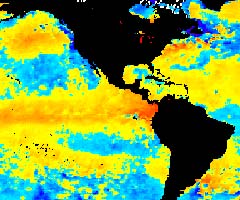| NOAA Magazine || NOAA Home Page |
EL
NIÑO ON TRACK TO INFLUENCE U.S. WINTER;
PREPARE FOR EL NIÑO’s DRIER AND WARMER WINTER,
NOAA EXPERTS TELL NORTHWEST OFFICIALS
 October
10 , 2002 — El Niño, already responsible for the drier-than-normal
conditions in Indonesia, India, Mexico and Central America, is expected
to continue influencing U.S. weather patterns into early 2003, forecasters
at the NOAA National Weather Service
said today. The Pacific Northwest will feel El Niño’s influence
during the 2002-03 winter in the form of drier and warmer-than-normal
conditions, but climate and weather experts from NOAA say the region still
could face damaging storms. (Click NOAA satellite image for larger
view of sea surface temperatures in the Eastern Pacific taken Oct. 7,
2002.)
October
10 , 2002 — El Niño, already responsible for the drier-than-normal
conditions in Indonesia, India, Mexico and Central America, is expected
to continue influencing U.S. weather patterns into early 2003, forecasters
at the NOAA National Weather Service
said today. The Pacific Northwest will feel El Niño’s influence
during the 2002-03 winter in the form of drier and warmer-than-normal
conditions, but climate and weather experts from NOAA say the region still
could face damaging storms. (Click NOAA satellite image for larger
view of sea surface temperatures in the Eastern Pacific taken Oct. 7,
2002.)
The agency's Climate Prediction Center issued its monthly El Niño update, highlighting the expected weather impacts in the United States and throughout the world.
Wayne Higgins of NOAA’s Climate Prediction Center in Camp Springs, Md., met with Seattle’s emergency managers and other local officials at a climate workshop on Thursday and said El Niño’s impact in the region will be weaker than the 1997-98 version.
“The current El Niño, while still holding the potential to bring strong storms, will continue the trend of below-average precipitation in the region,” said Higgins, NOAA’s principal scientist and an expert in long-range forecasting. Higgins added El Niño is at moderate strength.
Christopher Hill, meteorologist in charge of the NOAA National Weather Service Seattle forecast office, said, "The impact of a moderate El Niño on winter precipitation in the Pacific Northwest is not straightforward. There is a slight tendency for precipitation to average a little below normal, but that does not mean we won’t see significant storms with heavy precipitation and flooding.”
While the 2002-03 El Niño is weaker than the powerful 1997-98 version, forecasters said "strong impacts" are still likely in a few areas.
Overall, from December 2002 - April 2003, forecasters expect the U.S. to experience:
- Drier-than-average conditions in the Pacific Northwest and Mid-Atlantic states during fall 2002, and in the Ohio Valley states and northern Rockies during winter 2002-2003.
- Wetter-than-average conditions along much of the southern tier of the U.S. during winter 2002-2003.
- Warmer-than-average conditions in the northern tier states, southern and southeastern Alaska during late fall 2002 and early winter 2003.
NOAA's Climate Prediction Center is responsible for issuing seasonal climate outlooks for one to thirteen months in the future. The Climate Prediction Center is one of the National Centers for Environmental Prediction, which is a part of the NOAA National Weather Service. The National Weather Service is the primary source of weather data, forecasts and warnings for the United States and its territories and operates the most advanced weather and flood warning and forecast system in the world, helping to protect lives and property and enhance the national economy.
Relevant
Web Sites
NOAA's
Climate Prediction Center
El
Niño/Southern Oscillation (ENSO) Diagnostic Discussion
Weekly
El Niño/Southern Oscillation (ENSO) Update
Most
Recent 2 Months Sea Surface Temperature Anomaly Animation
El
Niño and La Niña-related Winter Features over North America
NOAA's El
Niño Theme Page
NOAA's El Niño Home Page
CLIMATE FACTORS HELPING TO SHAPE WINTER 2001-2002
NOAA's CURRENT SEA SURFACE TEMPERATURE
MAPS
ENSO
Fact Sheet
ENSO Frequently Asked Questions
ENSO
Tutorial
ENSO
Recent Events
Sea Surface Temperature Outlook
ENSO
Impacts by Region
NOAA's
Storm Watch — Get the latest severe weather information
across the USA
NOAA's Drought Information Center
Media
Contact:
Carmeyia
Gillis, NOAA Climate Prediction
Center, (301) 763-8000 ext. 7163